Abstract
The interrelationships among transpulmonary pressure, flow, and volume during exhausting exercise were studied in 12 males with chronic obstructive lung disease. Expiratory pressure during exercise was compared with flow-limiting pressure (Pmax) measured at rest. In 11 patients, expiratory pressure during exercise exceeded Pmax, indicating that ventilation became mechanically inefficient. Pmax values of the patients were lower than those of normal subjects. Evidence of expiratory flow augmentation during exercise was noted in two subjects. Since 10 subjects achieved maximal expiratory flow predicted from flow-volume curves when heart rate was not maximal, we conclude that exercise capacity in most subjects was clearly limited by the deranged ventilatory apparatus. Elevations in mean intrathoracic pressure during exercise also may interfere with venous return and impose an additional limitation.
Full text
PDF
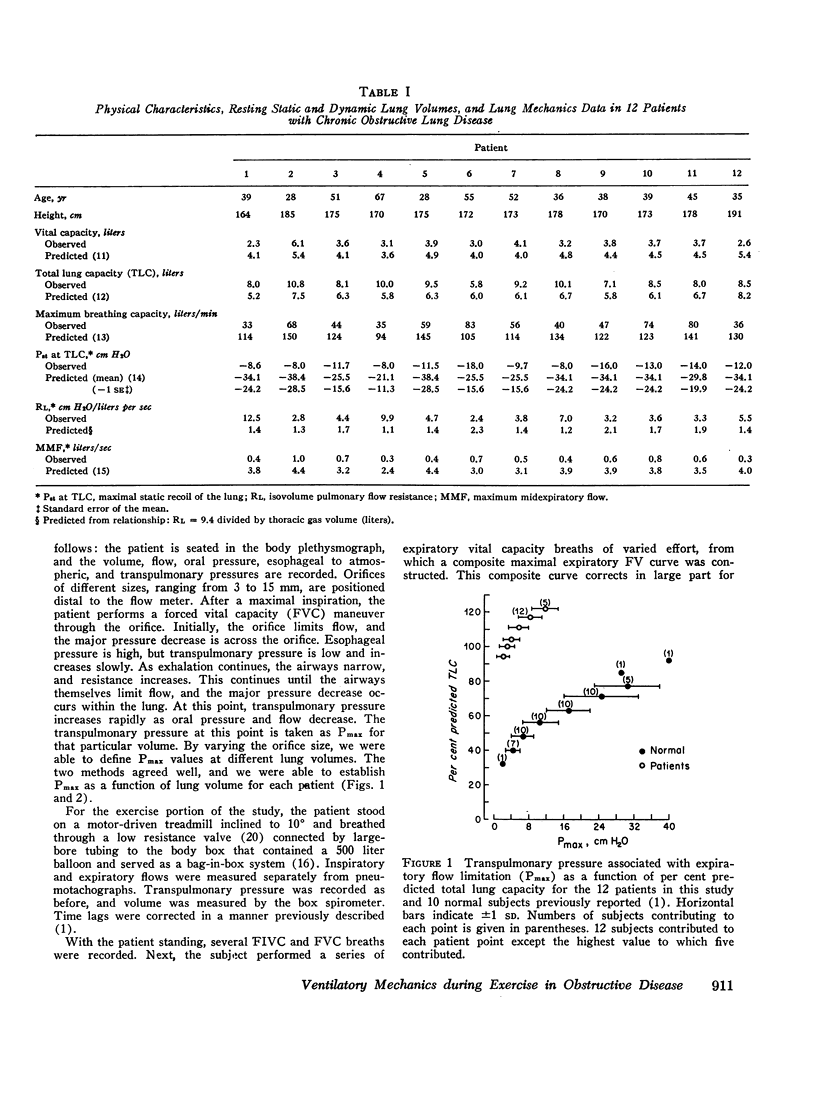
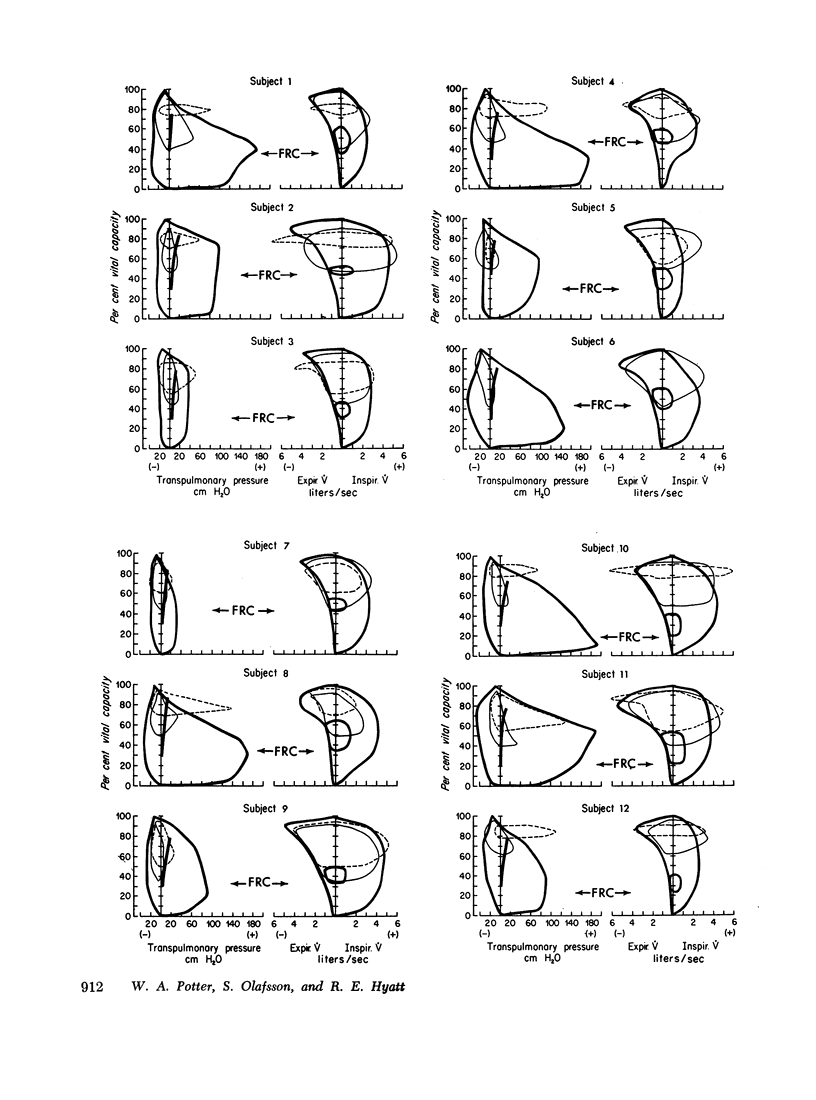
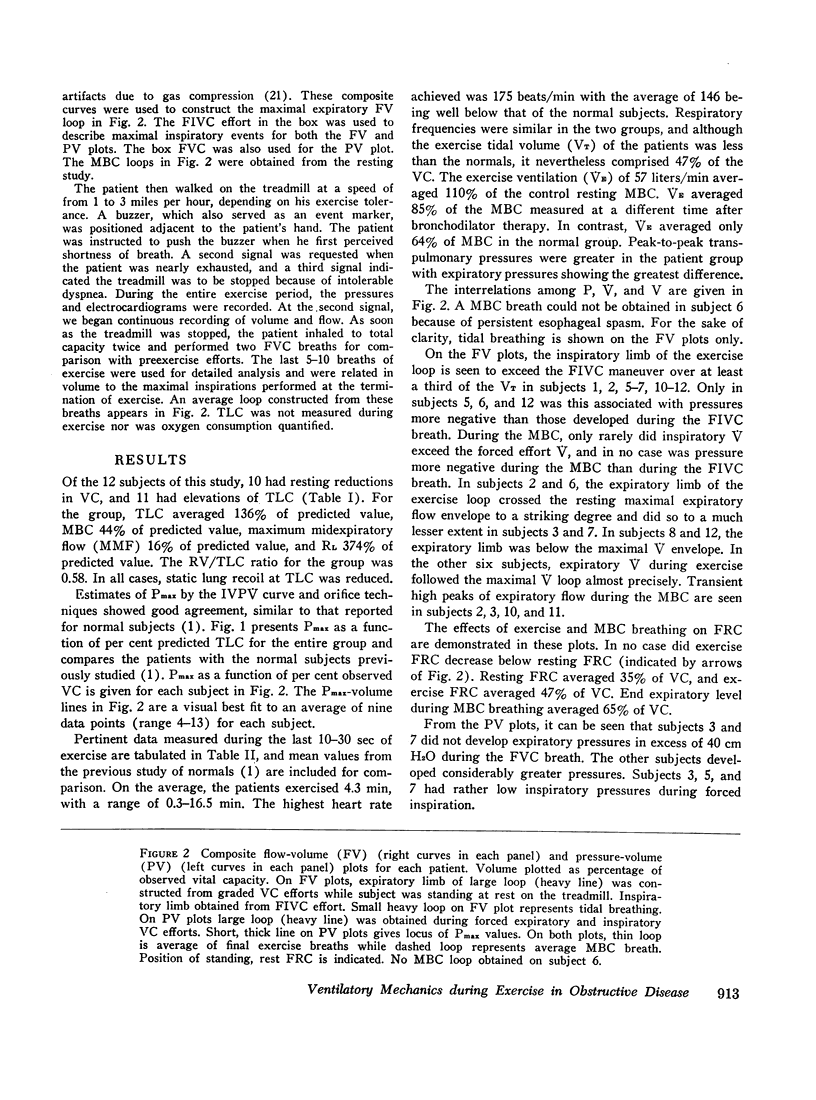
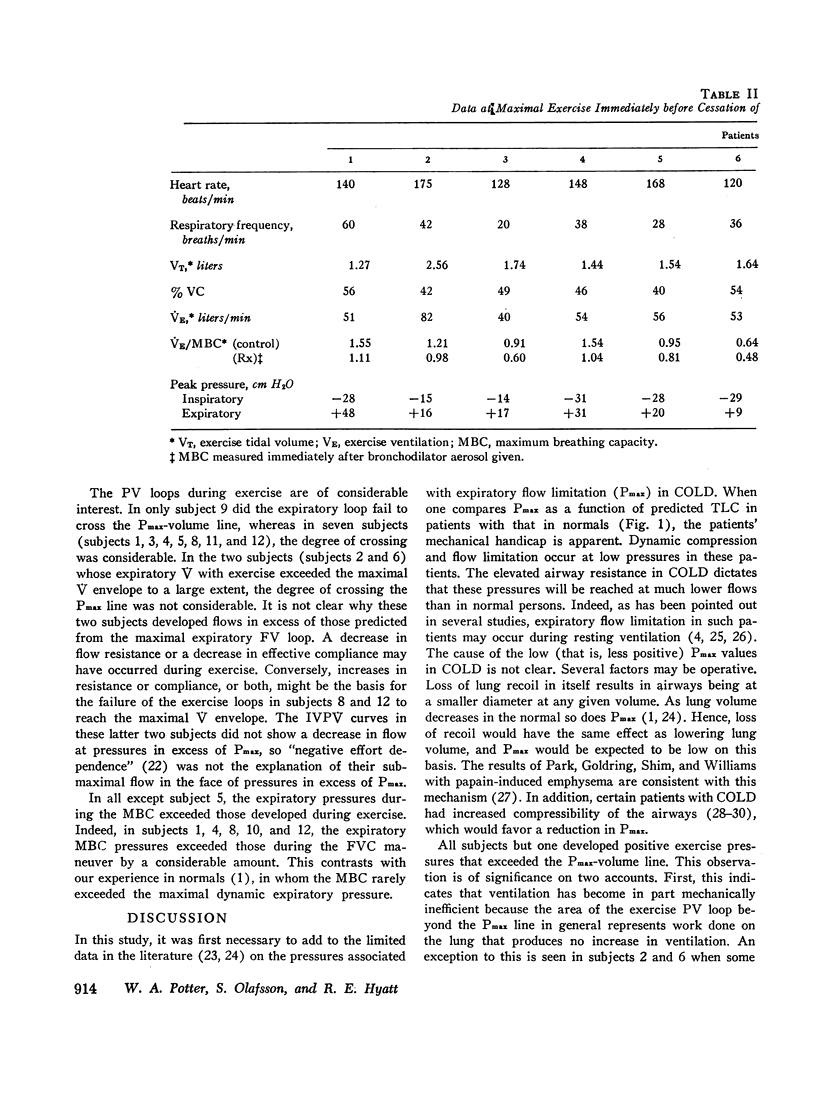
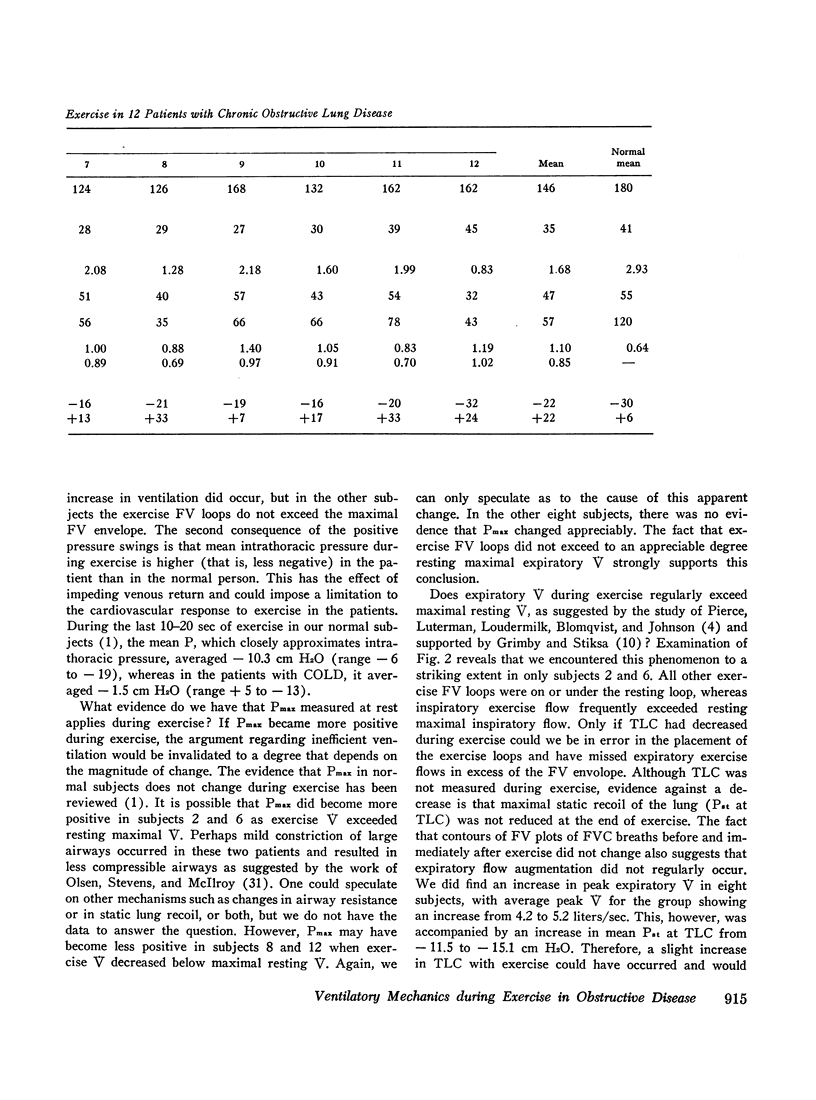
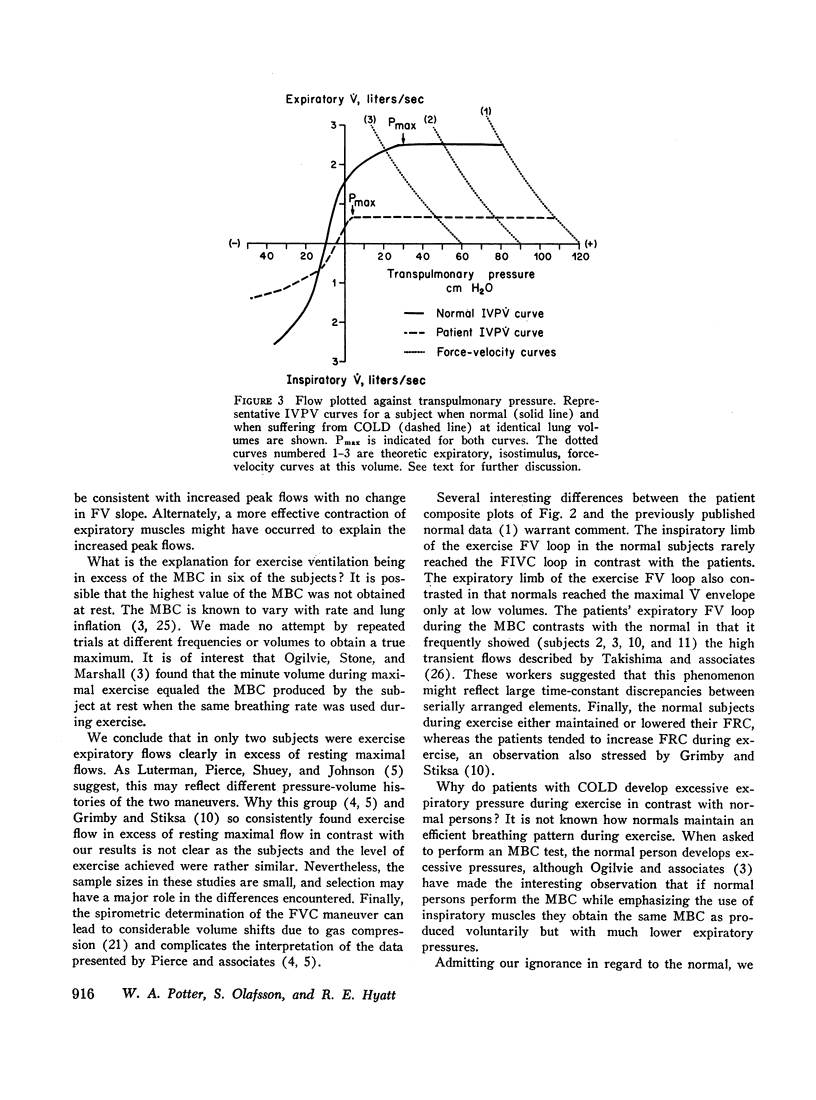
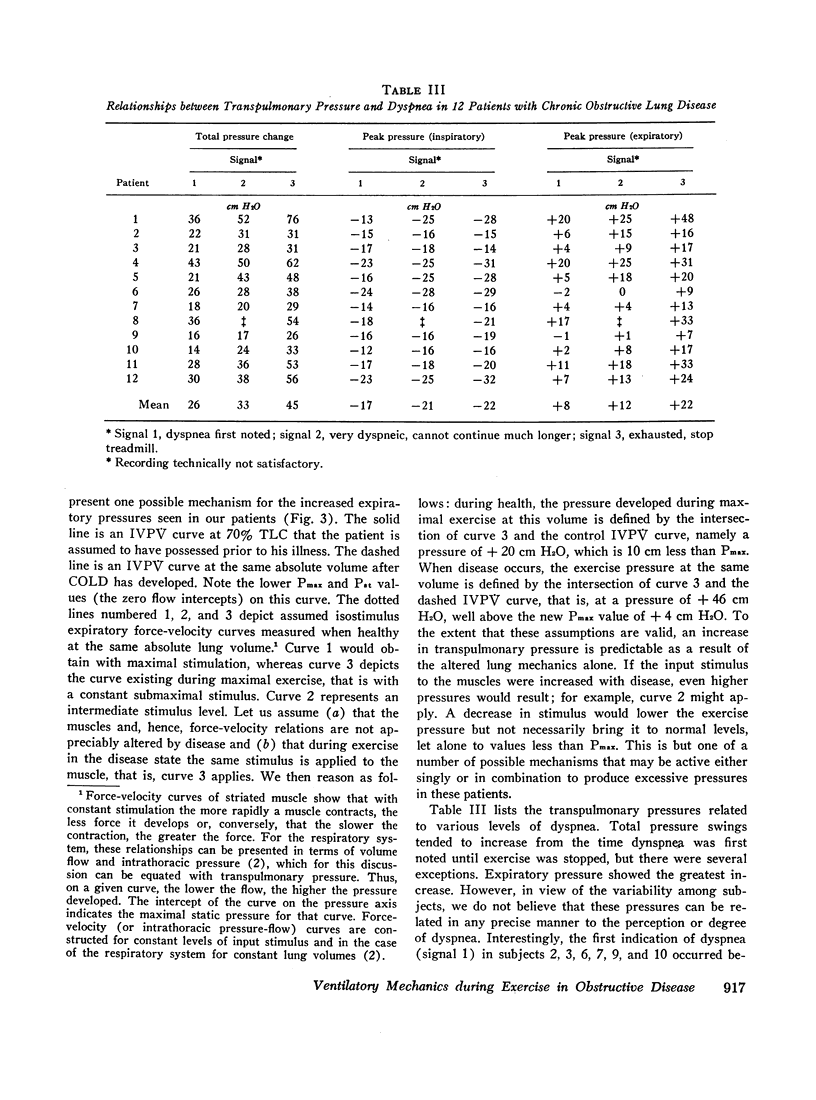
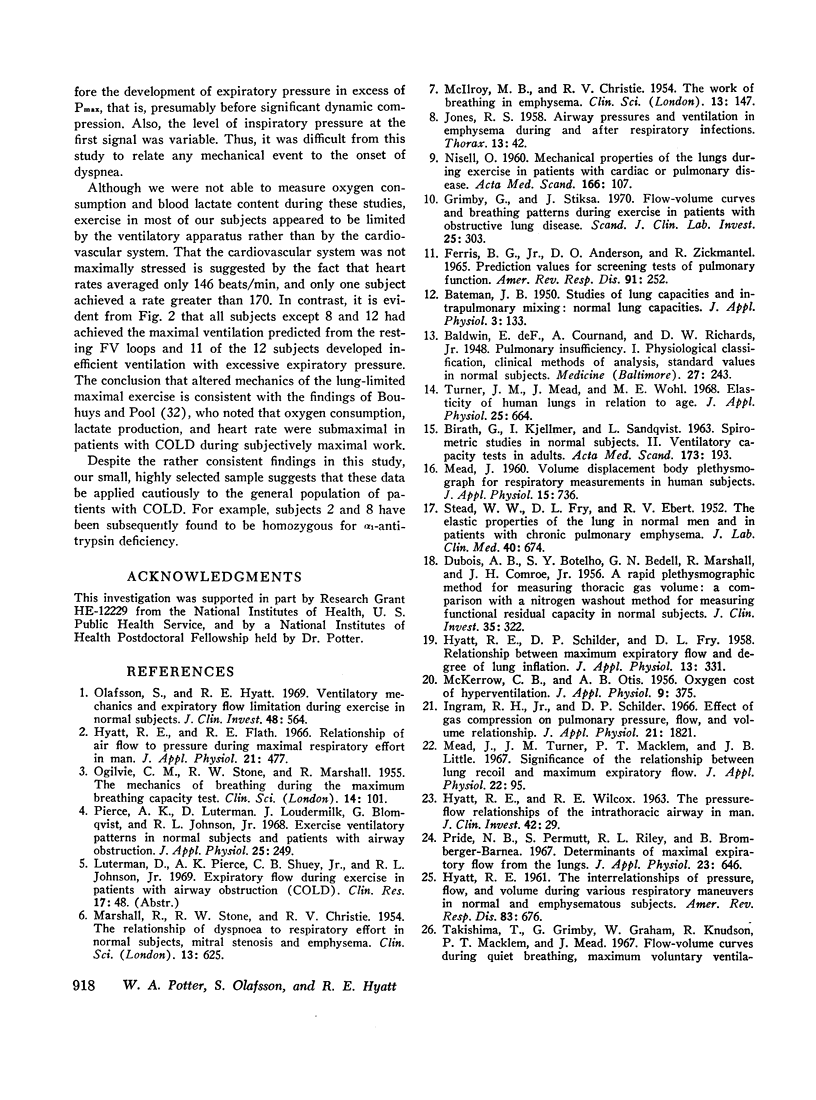
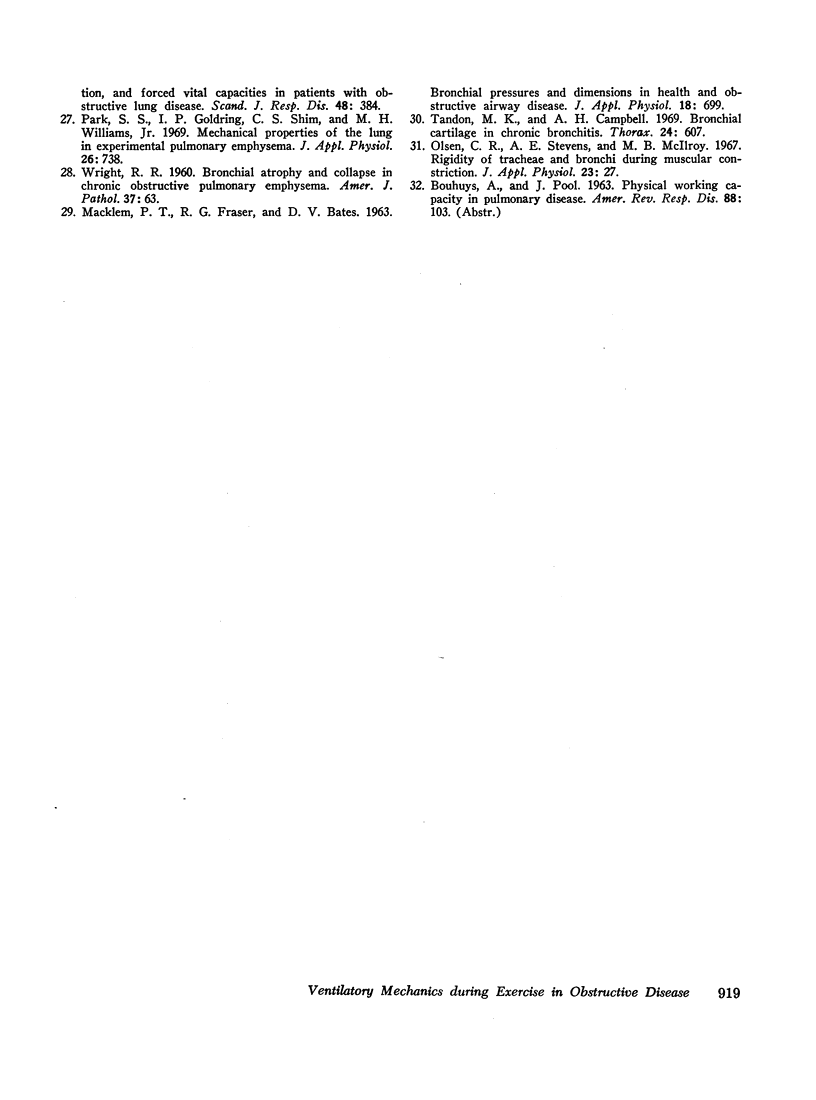
Selected References
These references are in PubMed. This may not be the complete list of references from this article.
- BATEMAN J. B. Studies of lung capacities and intrapulmonary mixing: normal lung capacities. J Appl Physiol. 1950 Sep;3(3):133–142. doi: 10.1152/jappl.1950.3.3.133. [DOI] [PubMed] [Google Scholar]
- BIRATH G., KJELLMER I., SANDQVIST L. Spirometric studies in normal subjects. II. Ventilatory capacity tests in adults. Acta Med Scand. 1963 Feb;173:193–198. [PubMed] [Google Scholar]
- DUBOIS A. B., BOTELHO S. Y., BEDELL G. N., MARSHALL R., COMROE J. H., Jr A rapid plethysmographic method for measuring thoracic gas volume: a comparison with a nitrogen washout method for measuring functional residual capacity in normal subjects. J Clin Invest. 1956 Mar;35(3):322–326. doi: 10.1172/JCI103281. [DOI] [PMC free article] [PubMed] [Google Scholar]
- FERRIS B. G., Jr, ANDERSON D. O., ZICKMANTEL R. PREDICTION VALUES FOR SCREENING TESTS OF PULMONARY FUNCTION. Am Rev Respir Dis. 1965 Feb;91:252–261. doi: 10.1164/arrd.1965.91.2.252. [DOI] [PubMed] [Google Scholar]
- Grimby G., Stiksa J. Flow-volume curves and breathing patterns during exercise in patients with obstructive lung disease. Scand J Clin Lab Invest. 1970 May;25(3):303–313. doi: 10.3109/00365517009046210. [DOI] [PubMed] [Google Scholar]
- HYATT R. E., SCHILDER D. P., FRY D. L. Relationship between maximum expiratory flow and degree of lung inflation. J Appl Physiol. 1958 Nov;13(3):331–336. doi: 10.1152/jappl.1958.13.3.331. [DOI] [PubMed] [Google Scholar]
- HYATT R. E. The interrelationships of pressure, flow, and volume during various respiratory maneuvers in normal and emphysematous subjects. Am Rev Respir Dis. 1961 May;83:676–683. doi: 10.1164/arrd.1961.83.5.676. [DOI] [PubMed] [Google Scholar]
- HYATT R. E., WILCOX R. E. The pressure-flow relationships of the intrathoracic airway in man. J Clin Invest. 1963 Jan;42:29–39. doi: 10.1172/JCI104693. [DOI] [PMC free article] [PubMed] [Google Scholar]
- Hyatt R. E., Flath R. E. Relationship of air flow to pressure during maximal respiratory effort in man. J Appl Physiol. 1966 Mar;21(2):477–482. doi: 10.1152/jappl.1966.21.2.477. [DOI] [PubMed] [Google Scholar]
- Ingram R. H., Jr, Schilder D. P. Effect of gas compression on pulmonary pressure, flow, and volume relationship. J Appl Physiol. 1966 Nov;21(6):1821–1826. doi: 10.1152/jappl.1966.21.6.1821. [DOI] [PubMed] [Google Scholar]
- JONES R. S. Airway pressures and ventilation in emphysema during and after respiratory infections. Thorax. 1958 Mar;13(1):42–47. doi: 10.1136/thx.13.1.42. [DOI] [PMC free article] [PubMed] [Google Scholar]
- MARSHALL R., STONE R. W., CHRISTIE R. V. The relationship of dyspnoea to respiratory effort in normal subjects, mitral stenosis and emphysema. Clin Sci. 1954 Nov;13(4):625–631. [PubMed] [Google Scholar]
- MCKERROW C. B., OTIS A. B. Oxygen cost of hyperventilation. J Appl Physiol. 1956 Nov;9(3):375–379. doi: 10.1152/jappl.1956.9.3.375. [DOI] [PubMed] [Google Scholar]
- McILROY M. B., CHRISTIE R. V. The work of breathing in emphysema. Clin Sci. 1954 Feb;13(1):147–154. [PubMed] [Google Scholar]
- Mead J., Turner J. M., Macklem P. T., Little J. B. Significance of the relationship between lung recoil and maximum expiratory flow. J Appl Physiol. 1967 Jan;22(1):95–108. doi: 10.1152/jappl.1967.22.1.95. [DOI] [PubMed] [Google Scholar]
- NISELL O. Mechanical properties of the lungs during exercise in patients with cardiac or pulmonary disease. Acta Med Scand. 1960 Feb 17;166:107–112. doi: 10.1111/j.0954-6820.1960.tb17359.x. [DOI] [PubMed] [Google Scholar]
- OGILVIE C. M., STONE R. W., MARSHALL R. The mechanics of breathing during the maximum breathing capacity test. Clin Sci. 1955 Feb;14(1):101–107. [PubMed] [Google Scholar]
- Olafsson S., Hyatt R. E. Ventilatory mechanics and expiratory flow limitation during exercise in normal subjects. J Clin Invest. 1969 Mar;48(3):564–573. doi: 10.1172/JCI106015. [DOI] [PMC free article] [PubMed] [Google Scholar]
- Olsen C. R., Stevens A. E., McIlroy M. B. Rigidity of tracheae and bronchi during muscular constriction. J Appl Physiol. 1967 Jul;23(1):27–34. doi: 10.1152/jappl.1967.23.1.27. [DOI] [PubMed] [Google Scholar]
- Park S. S., Goldring I. P., Shim C. S., Williams M. H., Jr Mechanical properties of the lung in experimental pulmonary emphysema. J Appl Physiol. 1969 Jun;26(6):738–744. doi: 10.1152/jappl.1969.26.6.738. [DOI] [PubMed] [Google Scholar]
- Pierce A. K., Luterman D., Loudermilk J., Blomqvist G., Johnson R. L., Jr Exercise ventilatory patterns in normal subjects and patientws with airway obstruction. J Appl Physiol. 1968 Sep;25(3):249–254. doi: 10.1152/jappl.1968.25.3.249. [DOI] [PubMed] [Google Scholar]
- Pride N. B., Permutt S., Riley R. L., Bromberger-Barnea B. Determinants of maximal expiratory flow from the lungs. J Appl Physiol. 1967 Nov;23(5):646–662. doi: 10.1152/jappl.1967.23.5.646. [DOI] [PubMed] [Google Scholar]
- STEAD W. W., FRY D. L., EBERT R. V. The elastic properties of the lung in normal men and in patients with chronic pulmonary emphysema. J Lab Clin Med. 1952 Nov;40(5):674–681. [PubMed] [Google Scholar]
- Takishima T., Grimby G., Graham W., Knudson R., Macklem P. T., Mead J. Flow-volume curves during quiet breathing, maximum voluntary ventilation, and forced vital capacities in patients with obstructive lung disease. Scand J Respir Dis. 1967;48(3):384–393. [PubMed] [Google Scholar]
- Tandon M. K., Campbell A. H. Bronchial cartilage in chronic bronchitis. Thorax. 1969 Sep;24(5):607–612. doi: 10.1136/thx.24.5.607. [DOI] [PMC free article] [PubMed] [Google Scholar]
- Turner J. M., Mead J., Wohl M. E. Elasticity of human lungs in relation to age. J Appl Physiol. 1968 Dec;25(6):664–671. doi: 10.1152/jappl.1968.25.6.664. [DOI] [PubMed] [Google Scholar]
- WRIGHT R. R. Bronchial atrophy and collapse in chronic obstructive pulmonary emphysema. Am J Pathol. 1960 Jul;37:63–77. [PMC free article] [PubMed] [Google Scholar]


